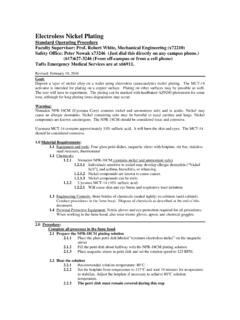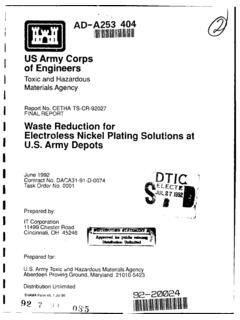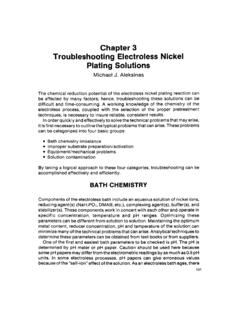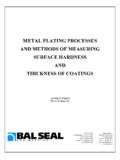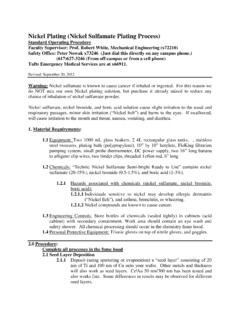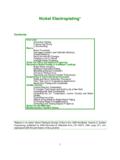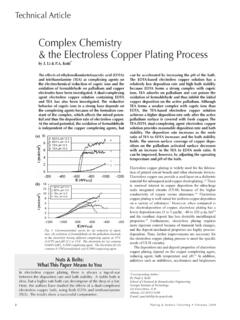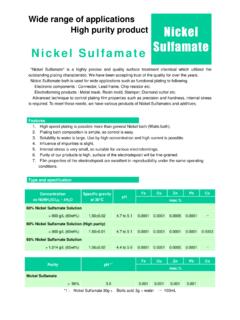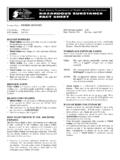Transcription of RECOVERY and PURIFICATION of NICKEL SALTS and …
1 SM/Technical Paper 14509/99 TECHNICAL PAPER 145 RECOVERY and PURIFICATION of NICKEL SALTSand CHROMIC ACID using the RECOFLO SYSTEMRONALD P. GOUTHRO, Technical Marketing Specialist, Eco-Tec Inc., Ontario, CanadaLLOYD VAZ, Technical Consultant, Thermax Ltd., (WTD), Pune, IndiaPresented at the Metal Finisher s Association of India, Mumbai, IndiaSeptember, a plating shop there are opportunities torecycle chemicals without sacrificingproduct quality. In fact, a well designedsystem can actually help a plater maintaincleaner, more productive 1975, several systems using thepatented Recoflo ion exchange processhave been successfully operated to reclaimand purify plating chemicals. This paper willdiscuss two specific applications of theRecoflo process, RECOVERY of NICKEL saltsand chromic salt recoveryNickel plating tanks are followed by severalcounterflowing rinse tanks to preventcontamination of subsequent chrome platingsolutions.
2 Plated parts typically carry out of plating solution into the rinses. Inmany plants this dragout solution ends up asa hazardous waste sludge that must betransported and disposed in a addition to the loss of material, the costsof removing the NICKEL from the rinse watercan be substantial:i) NICKEL is a toxic heavy metal, requiringchemical treatment and precipitation,ii) sludge produced is considered to behazardous and must be stored in asecure landfill,iii) labor is required for treatment anddisposal,iv) there is a long term liability associatedwith the disposal of hazardous economic and legal considerations,coupled with a desire to be environmentallyresponsible, lead many platers to recoverand recycle NICKEL SALTS from rinsing considerationsKey objectives for most platers include theneed to get production out on time, to meetor exceed customer expectations and tokeep production costs within budget.
3 Thepurpose of a recycling strategy is to reduceproduction costs. Recycling chemicals can,however, lead to troubles with the platingsolutions if care is not taken with the designand operation of the system. A number offactors must be ) Purity - Contaminants that haveaccumulated in the rinse tanks should beremoved before the NICKEL solution isrecycled to the plating bath. If not, theserecycled contaminants would buildup inthe bath and cause an adverse effect onthe plating quality and bath ) Brighteners - Brighteners are usuallysodium- SALTS of organic compounds andthey are consumed / degraded in theplating process or lost to actually provides an importantoutlet for degraded brighteners andsodium. While recycling brightenersmight appear to be beneficial, fourproblems can be encountered:SM/Technical Paper 14509/99 TECHNICAL PAPER 145 degraded brighteners are recovered,increasing the load on carbon filters, some decanting of the tank may berequired to control sodium levels, brightener control is difficult when aportion of the brightener package isrecycled, SALTS recycled to the semi-brighttanks cannot contain ) Composition - The recovered solutionshould be sufficiently concentrated sothat the volume can be returned to theplating tank without the need foradditional evaporation equipment.
4 Anickel concentration of 30-40 g/L isusually sufficient. As the NICKEL existsas both a chloride and sulfate salt in theplating tank, it is preferable to recover itin this mixed ) pH - The pH of the recycled nickelsolution should be in the correct range tofacilitate direct return to the plating enters unwanted chemicalsto the ) Concentration - In duplex NICKEL platingsystems, it is common for plated parts tomove from the semi-bright tank to thebright tank without an intermediaterinsing step. As the NICKEL salt contentsof the two tanks are similar, the dragoutfrom the semi-bright tank replenishes thesalt content in the bright tank. NICKEL saltsrecovered from the rinses after thebright tank must be recycled to the semi-bright NICKEL plating consists of a brighttank only, the salt content of the tank willgradually decline due to dragout.
5 Thisfact, combined with the evaporativelosses from the tank, makes it possible torecycle most or all of the recoverednickel must be taken, however, asanodes typically operate at highercurrent efficiencies than cathodes. Thismeans that, if all the dragout is recycled,the salt level in the tank can graduallyincrease. This can be controlled with theuse of specially designed, RECOVERY alternativesThere are a number of separationprocesses which have been used torecover NICKEL )Evaporation - Simple humidification-type evaporators can be attached to theplating tank, or self-sufficient steam-firedunits can be used to concentrate thenickel rinse water. Evaporation canusually recover over 90% of thedragout, provided there are enough rinsetanks to ensure good cleaning of theparts before chrome plating .
6 Evaporatorsare simple to operate, can be veryinexpensive to purchase, and canprovide a very concentrated (>40 g/L)product. The main drawback toevaporation is that all dissolved materials(including degraded brighteners, sodiumand tap-water contaminants) arerecovered, making recycle )Reverse osmosis - Rinse water ispressurized against a semi-permeablemembrane that rejects almost alldissolved materials, including organicbrighteners. These units can treat largervolumes, making rinsing much easier,while recovering >95% of the nickelsalts. While often more expensive thansome evaporators, reverse osmosis(RO) units can produce a fairlyconcentrated 10-20 g/L product. Themain weakness with RO is membranelife, inability to reduce NICKEL to low ppmlevels in the reject, and sodium /brightener RECOVERY in the )Electrodialysis - Rinse water ispumped through a stack of ion-selectivemembranes that allow NICKEL , sodium andother cations to pass through when anelectrical current is applied.
7 Nickelpasses into an acid solution, which mustbe neutralized to the proper pH forSM/Technical Paper 14509/99 TECHNICAL PAPER 145reuse. Over 99% of the NICKEL canbe recovered and treatingrelatively large volumes ispossible. Membrane life andserviceability can be a concernwith electrodialysis )Ion exchange - Ion exchangeuses a column of chemically activeresin beads that exchangehydrogen for NICKEL . Acidregeneration of the resin yields arelatively concentrated NICKEL saltsolution, with >97% of the nickelfrom the rinse water. Ionexchange can economically treatlarge volumes of rinse water andremove NICKEL to very low part-per-million (ppm) levels. Theexcess acid in the recovered NICKEL saltsmust be neutralized to the proper pH forreuse. Also, the acidic, NICKEL -free rinsewater must be neutralized prior )Electrowinning - In addition to theabove, electrowinning has been used toa limited degree.
8 A modified platingprocess is used to reduce NICKEL levelsin the rinse water. There are a numberof problems with this method, including: inability to plate out NICKEL to ppmlevels, difficulty in harvesting and reusingnickel metal, RECOVERY of brightener compoundsin metal, complex equipment 1 summarizes the capabilities of advanced Recoflo Systemfor NICKEL recoveryOriginally commercialized in 1970, patentedRecoflo ion exchange technology has beenused for a wide variety of chemicalrecovery applications. Recoflo ischaracterized by its use of:i) fine mesh resin,ii) fully-packed resin columns,iii) counter-current regeneration,iv) short resin Recoflo System is a pre-assembled,skid mounted device that is fully tested, priorto shipment. The resin columns are mountedon an epoxy coated steel frame withprocess valves, internal piping and a designed for NICKEL RECOVERY , theRecoflo method immediately offers asignificant improvement in NICKEL removalefficiency and product concentration (up to40 g/L as NICKEL ).
9 More importantly, theRecoflo System offers a number of otherimportant features. Specifically, the Systemis designed to:i) reject organic has beenapproved by OEM parts suppliers forduplex NICKEL ,ii) reject accumulation inthe plating tank does not occur,iii) regenerate with sulfuric andhydrochloric saltsmatch the tank chemistry,iv) remove and reuse excess acid from therecovered does notupset bath pH,SM/Technical Paper 14509/99 TECHNICAL PAPER 145v) incorporate specially designed, plating balances anodedissolution, ensuring that all recoveredsalts can be (Simultaneous Thickness andElectrochemical Potential) test, developed byEnthone-EMI, is a widely accepted qualityassurance rating for duplex NICKEL coatingsin the automotive industry. AutomotiveOEMs are mandated to have of 100 mV or greater on their finalplated test results were collected on aduplex NICKEL plating tank from a long timeuser (16 years) of a Recoflo System.
10 Ascan be seen from the data in Figure 1, results clearly indicate that recyclingnickel SALTS recovered from the RecofloSystem had no adverse effects on thequality of the plated ensuring that all the SALTS recovered canbe safely and fully recycled, the RecofloSystem for NICKEL RECOVERY can reducerelated operating costs by over 90% andrecover over 99% of the NICKEL . See Table Inc., located in the United States,has been the primary supplier of brand namehand tools for Sears & Roebuck since has eight plating tanks withapproximately 53,000 liters of semi-brightand bright plating solution. In mid-1996,Danaher Tool Group became concernedabout the NICKEL waste emanating from in itsNorth Carolina Operation. Without any metalreclaiming system in use, NICKEL drag-outfrom Danaher s plating tanks averaged per day.

